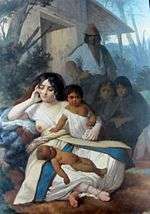Elisa Bravo
Elisa Bravo Jaramillo de Bañados (also spelt Eliza) was a passenger on Joven Daniel when this ship was wrecked on the coast of Araucanía, south-central Chile in 1849. She was rumoured to have survived and held captive by local Mapuches; her supposed plight caused a stir and was even the subject of two paintings by Raymond Monvoisin.


She was born in Valdivia, Chile, the daughter of Miguel Bravo Aldunate and Carmen Jaramillo Jaramillo. She married Juan Bañados Berendique on 12 October 1846.[1]
The shipwreck
In the winter of 1849, the Spanish brig Joven Daniel was sailing on the Pacific coast of Chile from Valparaíso to Valdivia.[2] Several passengers were on board, including trader Don Ramon Bañados, his wife Dona Elisa Bravo and a baby a few months old.[2] The ship capsized on the coast near the Imperial River[3] and was completely wrecked; none or only a few passengers and crew survived.[4][5]
According to one version of the events a short distance inland, the survivors found an Indian settlement and, despite their trepidation, were welcomed by the cacique (chief) and promised protection.[4] They responded by salvaging whatever they could from the ship as a gift for him.[4] Unfortunately, the gift included a cask of rum, which the Indians proceeded to consume, after which they decided to murder the Spaniards[4] by the cruellest methods.[3] Many versions of the story conclude that no-one from the Joven Daniel survived.[4] The findings of the commissioner of nations, José Antonio Zúñiga, concur.[3] 20th and 21st-century historians such as Gabriel Guarda and José Bengoa have however challenged the notion that there were no survivors.[5] As of 2010 there was no consensus among historians on what really happened.[5]
Stories of the fate of Elisa Bravo
However, there were various reports that Elisa Bravo may have been taken captive by the Indians and was still alive, living as wife to the cacique,[4] in what is described as the most brutal forced coexistence[3] resulting in children of "mixed blood".[6]
Troops were sent from Valdivia to rescue her, but could not even find her body; an Indian told them that she was buried on the beach with her young child and her servant, with just three stones to mark the place.[2]
Then in March 1853, a report appeared in The Times in London that Bravo had been found by a farm worker who had travelled into the interior in search of cattle. He met with a young woman whom he identified by the description she gave of herself and her parents. The piece concludes, "It is to be hoped that the long lost child will shortly be restored to her parents."[7] However, there is no subsequent report of any such reunion.
Traveller Guillermo Cox is said to have seen Elisa Bravo in 1863.[5]
Another report dating from 1863 said that her captors, fearing vengeance from Spaniards, sold her to Calfucurá Indians in Puelmapu for a hundred mares, but that she had died after three years.[8]
Social background and implications
Several aspects of the story served to reinforce prejudices of the time, and were useful in justifying policies of colonisation and the evangelisation and subjugation of indigenous peoples.[6]
The effect of alcohol on the Indians is described in graphic terms: "… Indians cannot resist it, and drink it […] till they get mad or helpless".[4] Their transformation from civil welcome to diabolical murderers is presented as evidence of their uncivilised primitive barbarity,[4] embodying the wild idea of evil.[6]
Elisa Bravo, by contrast, presents a figure of heroic virtue, the stereotype of the virtuous woman resisting, albeit unsuccessfully, the depraved savages who immolate her companions and violate her,[6] producing a family of mestizos (mongrels).[3] This aspect of the story inspired Monvoisin in his two paintings of her.[3]
References
- Guarda, Gabriel (2006). La sociedad en Chile austral antes de la colonización alemana : Valdivia, Osorno, Río Bueno, La Unión: 1645-1850. Ediciones Universidad Católica de Chile. p. 454. ISBN 9561408678. OCLC 128386928. Retrieved 26 June 2019.
- Mariano Latorre (1971). Memorias Y Otras Confidencias. Andres Bello. pp. 144–. GGKEY:X4PCJZCLT60.
- Sergio Villalobos R. (1 January 1995). Vida fronteriza en la Araucanía: el mito de la Guerra de Arauco. Andres Bello. pp. 203–. ISBN 978-956-13-1363-7.
- R. Nelson Boyd (1881). "Chili: sketches of Chili and the Chilians during the war 1879–1880". London: Wm H Allen & Co. Retrieved 10 September 2016.
- Muñoz Sougarret, Jorge (2010). "El naufragio del bergantín Joven Daniel, 1849. El indígena en el imaginario histórico de Chile". Tiempo Histórico (in Spanish) (1): 133–148.
- María Luisa Candau Chacón; Mónica Bolufer Peruga; Alonso Manuel Macías Domínguez; Manuel José de Lara Ródenas; Sara López Villarán; Antonio José Couso Liañez; Marta Ruiz Sastre; Ofelia Rey Castelao; María José Álvarez Faedo; Tomás A. Mantecón Movellán; Rosario Márquez Macías; María Losada Friend; Clara Zamora Meca; Verónica Undurraga Schüler; Yéssica González Gómez; María José de la Pascua Sánchez (11 May 2016). Las mujeres y las emociones en Europa y América. Siglos XVII-XIX. Ed. Universidad de Cantabria. pp. 420–. ISBN 978-84-8102-770-9.
- "The Pacific". News. The Times (21383). London. 23 March 1853. p. 5.
- Sir Woodbine Parish (1863). Viaje a la Patagonia (PDF). p. 120. Retrieved 10 September 2016.